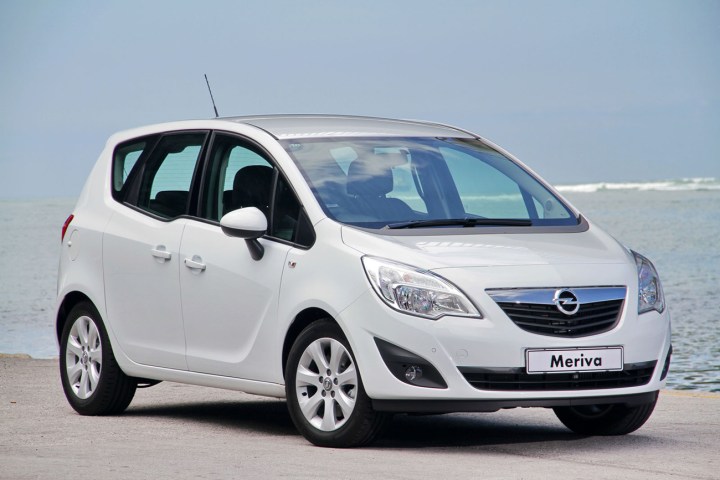Maverick Life, Sci-Tech, South Africa
Opel Meriva: More than just a merry van

In a new vehicle market as competitive as the South African one, producing a good car simply isn’t good enough anymore: it has to be exceptional. Opel is hoping its latest compact people carrier will exceed the most elevated expectations. Besides, the new Meriva has a few tricks up its sleeve… By DEON SCHOEMAN.
The first-generation Meriva won’t go down as the most memorable of cars. The compact people carrier was simply too small to be taken seriously in the MPV context, while the styling was innocuous rather than attractive.
Nevertheless, the Meriva nameplate has lived on to fight another day. And the new-generation model improves on its predecessor in almost every respect.
Vitally, it’s bigger and a lot more spacious, without becoming bloated and unwieldy in the process. The shape expresses an understated agility that promises ease of use rather than sporty dynamics, while generous glass areas suggest good visibility.
The front-end treatment is pure Opel, with the trapezoidal grille’s brightwork dominating proceedings. The large headlight clusters are equipped with now-ubiquitous daytime running lights, while extensive colour coding ensures a cohesive visage.
The rear is tidy, with a large tailgate that opens to bumper level, allowing convenient access to the luggage compartment. There’s a sloping roofline to provide a more streamlined look than the otherwise boxy dimensions would imply, but there’s no disguising that this is an MPV, with all the pragmatic implications that implies.
In profile, the Meriva’s rear doors are what attract the most attention – admittedly an unusual aspect, but one that defines the innovative element the new Meriva relies on so heavily. Immediately noticeable is how the window line dips just behind the B-pillar, adding an interesting visual kick to the glass area.

Perhaps more important from a functional point of view, however, is the positioning of the door handle: it’s located almost directly adjacent to the that of the front door, confirming that the rear door is actually rear-hinged.
In classic car parlance, one would refer to this arrangement as a suicide door, and it’s one that’s rarely seen in the modern car context: Rolls Royce, for one, subscribes to the configuration, as did the mould-breaking but now defunct Mazda RX-8.
The Meriva’s rear doors may open in the ‘wrong’ direction, compared to convention, but they’re not true suicide doors either, because the traditional B-pillar remains in place. That has good and bad implications.
The B-pillar is a key part of a car’s structural integrity, and doing away with it creates engineering challenges which are usually clunky and expensive. But with the B-pillar still in place, some of the rear-hinged door’s benefits are undone: the aperture revealed when opening the door is no larger than that of a normal door.
So why the rear-hinged doors? Because, Opel believes, they provide superior access to the rear bench seat, and open wider than a normal door. And indeed, that turns out to be the case in practice, too – although, it also takes some getting used to.
The doors open at an angle of almost 90°, compared to the 67° average of a conventional car, which allows easy and convenient entry and exit, and also makes fitting and removing baby seats much more convenient – important given the family-orientated target market of the Opel.
The rear doors aren’t the only part of the Meriva package that could be termed innovative. The rear bench seat and cargo area can be configured in a variety of ways, depending on number of occupants, and luggage space requirement.
Thus, the rear seat can be moved backwards, and the seat cushions pulled further apart, to boost legroom and create a more relaxed space for two rear occupants, albeit at the expense of cargo carrying capacity. In its normal position, there’s space for three at the back. And the rear seat can also be folded flat in stages to create a luggage compartment of up to 1,500-litres.
The FlexSpace system, as Opel has dubbed it, was already a feature of the first Meriva, but has been improved for its application here and is much more user-friendly.

The new Meriva has a centre console that can be configured in a variety of ways, depending on the preferences of its occupants. It features various interchangeable storage units that can be moved forwards or backwards on a rail system – simple, but clever.
The ambience of the interior is unexpectedly upmarket, with a full house of features that range from dual-stage climate control and multi-speaker sound to electric windows and mirrors, remote central locking, a multifunction steering wheel and cruise control.
Would-be Meriva buyers get to choose between two variants – the Enjoy and the Cosmo – of which the latter is the more upmarket, and also commands a dearer asking price. In addition to some minor specification differences and more upmarket finishes, the biggest difference between the two is a full-length glass roof, with a motorised shade that can be deployed or retracted at the push of a button.
The mechanical underpinnings are identical in both cases. Opel clearly subscribes to the current trend of smaller-capacity, turbocharged engines in an effort to provide enough urge while keeping fuel consumption and emissions under control.
Thus the Meriva is powered by a 1,364cc turbo engine with a healthy output of 103kW at 4,900rpm, and a torque peak of 200Nm, already on stream from 1,850rpm. The four-potter feels eager from the word go, and always offers enough urge to ensure surprisingly spirited performance.
Drive is to the front wheels via a six-speed manual gearbox that has a decent shift action, and a gear lever placed just right. In fact, the overall ergonomics are excellent, with a comfortable driving position and loads of adjustment scope: the driver seat can be raised or lowered, and the steering wheel can be adjusted for rake and reach.
The Meriva’s primary switchgear is intuitive enough, but the sea of buttons and controls in the central dashboard area is daunting at first and takes some getting used to. At least the main instruments are well placed and clearly legible.
The Meriva surprises and delights on a dynamic level. For what is, for all intents and purposes, a mom’s taxi, the little MPV reacts to driver input with enthusiasm, and will even chirp its tyres off the mark when you’re in a hurry.
Mid-gear acceleration is eager, although you’ll need to keep that turbo on the boil. At cruising speeds, effective overtaking requires some assistance by gearing down from the top ratio, but that’s really the only reminder that the mill under the bonnet is only 1.4-litres big.
The handling is confident, and the Meriva shows lots of composure in the twisties, even when pressing on. Clearly, your average Meriva driver is unlikely to treat it like a sports car, but it’s good to know that there’s plenty of grip, and that body roll is notable only by its absence, despite the taller stance and raised seating position.
In this second-generation guise, the Opel Meriva is a far more convincing package than before. It now has the space, the tactile quality, the spec and the dynamic appeal to go with the versatility and flexibility expected of a compact MPV. Those rear doors emphasise that innovation remains part of the deal too.
Thus, Opel has every right to be bullish about the Meriva’s prospects on local shores. It may also end up being a welcome ambassador for a brand that remains underrated, certainly in the South African market. DM



















 Become an Insider
Become an Insider